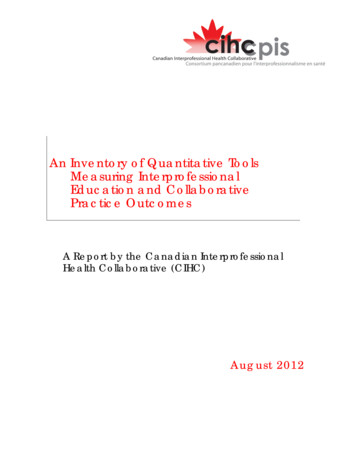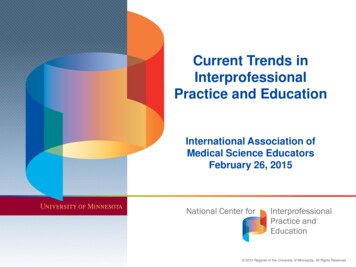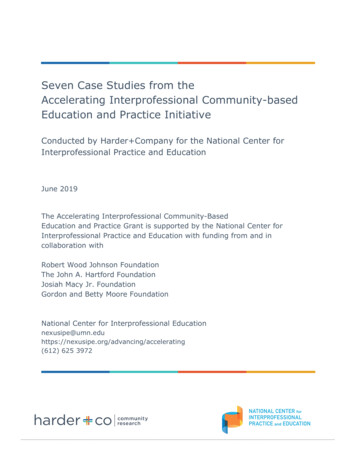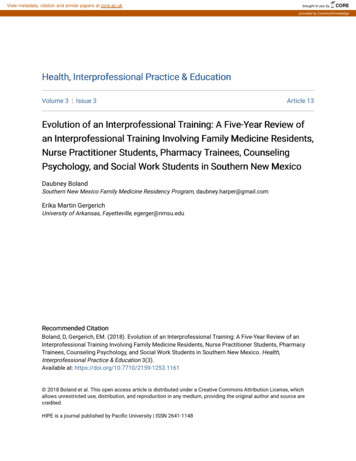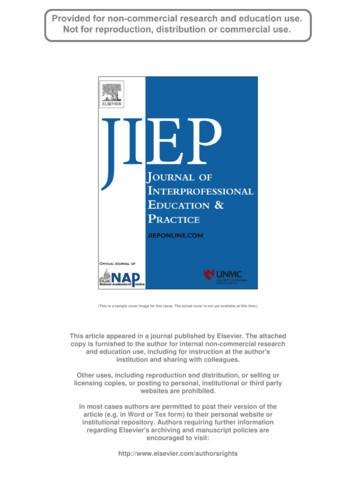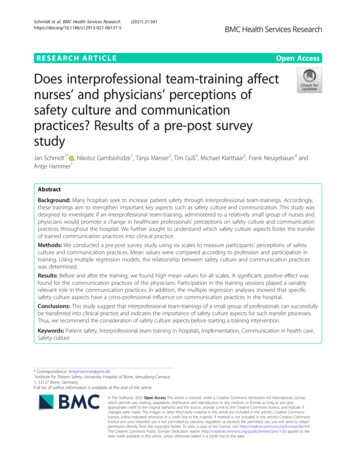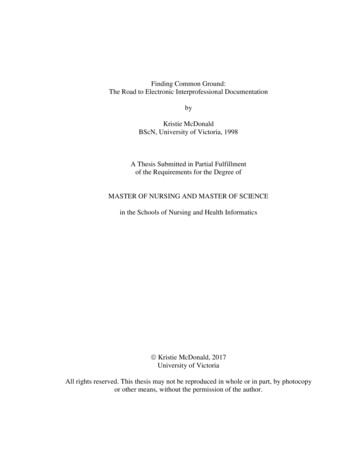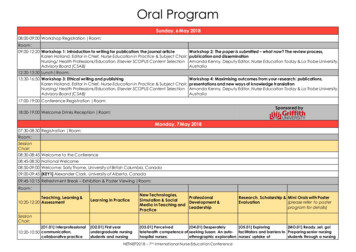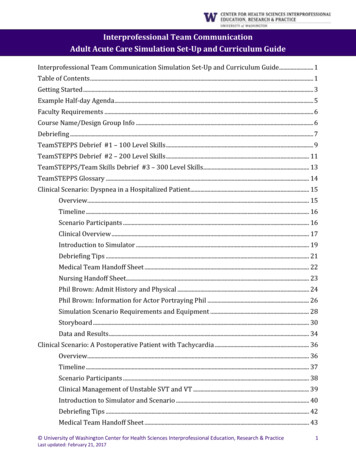
Transcription
Interprofessional Team CommunicationAdult Acute Care Simulation Set‐Up and Curriculum GuideInterprofessional Team Communication Simulation Set‐Up and Curriculum Guide. 1Table of Contents . 1Getting Started . 3Example Half‐day Agenda. 5Faculty Requirements . 6Course Name/Design Group Info . 6Debriefing . 7TeamSTEPPS Debrief #1 – 100 Level Skills . 9TeamSTEPPS Debrief #2 – 200 Level Skills . 11TeamSTEPPS/Team Skills Debrief #3 – 300 Level Skills. 13TeamSTEPPS Glossary . 14Clinical Scenario: Dyspnea in a Hospitalized Patient. 15Overview. 15Timeline . 16Scenario Participants . 16Clinical Overview . 17Introduction to Simulator . 19Debriefing Tips . 21Medical Team Handoff Sheet . 22Nursing Handoff Sheet. 23Phil Brown: Admit History and Physical . 24Phil Brown: Information for Actor Portraying Phil . 26Simulation Scenario Requirements and Equipment . 28Storyboard . 30Data and Results. 34Clinical Scenario: A Postoperative Patient with Tachycardia . 36Overview. 36Timeline . 37Scenario Participants . 38Clinical Management of Unstable SVT and VT . 39Introduction to Simulator and Scenario . 40Debriefing Tips . 42Medical Team Handoff Sheet . 43 University of Washington Center for Health Sciences Interprofessional Education, Research & PracticeLast updated: February 21, 20171
Interprofessional Team Communication SimulationSet‐up and Curriculum GuideNursing Handoff Sheet. 43Surgical Clinic History and Physical for Paul Smith. 44Equipment . 45Storyboard . 48Data and Results. 51Clinical Scenario: A Teenager with Asthma . 55Overview. 55Timeline . 56Scenario Participants . 57Clinical Overview of Asthma Exacerbation . 58Introduction to Simulator and Scenario . 59Debriefing Tips . 61Micah: History and Physical . 62ER Triage Sheet. 62Information for Simulation Tech Voicing Micah . 63Information for Actor Playing Micah’s Grandma . 65Equipment and Supplies . 66Pediatric Pulmonary Clinic Note . 68Storyboard . 70Patient Labs and Studies. 75 University of Washington Center for Health Sciences Interprofessional Education, Research & PracticeLast updated: February 21, 20172
Interprofessional Team Communication SimulationSet‐up and Curriculum GuideGetting StartedPurpose: Interprofessional Team Communication Simulation Set‐up and Curriculum GuideThe content in this set‐up guide was developed by the Macy grant team at the University ofWashington, who were funded in 2008 to develop and integrate interprofessional team traininginto existing curriculum in the Health Sciences schools of Medicine, Nursing, Pharmacy and thePhysician Assistant Program.The instructions in this guide are for LEAD INSTRUCTORS setting up interprofessional teamtraining using simulation as the vector by which health sciences students can learn together todevelop and improve basic, intermediate and more advanced levels of communication skills. TheMacy team used Team Strategies and Tools to Enhance Performance and Patient Safety(TeamSTEPPS) as a framework for the team communication training (see figure 1).The four trainable teamworkskills/competencies described in the modelinclude: 1) leadership; 2) situationmonitoring; 3) mutual support; and 4)communication. A highly functioning teamthat masters these competencies can attainthree possible teamwork outcomes: 1)performance; 2) knowledge; and 3) attitudes.Further htmThe content was piloted in 2010 with a group of 50 students and then rolled out to a larger groupof 300 students in 2011.This guide provides the content and the structure used by the Macy grant team to set‐up and runtheir simulation scenarios.Organization of contentThis guide is organized as follows:Example Half‐Day Simulation Session Agenda: Used by the Macy Grant Team when conductingtheir team communication training. Depending on group size, simulations can be runsimultaneously or as a progressive series of simulations.Faculty Requirements: It is ideal if at least one of the facilitators in the group has someknowledge and familiarity with TeamSTEPPS, instructional background using simulation, and theclinical knowledge needed to run the scenario. Often the instructors may need to step in and help University of Washington Center for Health Sciences Interprofessional Education, Research & PracticeLast updated: February 21, 20173
Interprofessional Team Communication SimulationSet‐up and Curriculum Guidethe students with clinical knowledge in order to keep the scenario on track so students can focuson communication skills rather than medical management.TeamSTEPPS Debriefing Guide: Includes the communication objectives to cover in thesimulations scenarios. Ideally, the curriculum is designed to run three scenarios. Each scenariobuilds on each other and progresses from basic to more advanced level communication skills.Scenario 1: BasicTeamSTEPPS skills(100 level)Scenario 2: IntermediateTeamSTEPPS skills(200 level)Scenario 3: AdvancedTeamSTEPPS(300 level)TeamSTEPPS Glossary. Summarizes the most frequently used TeamSTEPPS concepts andterminology. The Macy Grant Team passed out the glossary to students during the simulationtraining for quick reference.Simulation Scenarios. The Macy Grant Team developed three simulation scenarios.1. Clinical Scenario: Dyspnea in a Hospitalized Patient2. A Postoperative Patient with Tachycardia3. A Teenager with AsthmaEach simulation scenario section includes the following: OverviewTimelineScenario ParticipantsClinical OverviewIntroduction to SimulatorDebriefing TipsHandoff Sheets (if applicable to scenario)Admit History and PhysicalInformation for Actors playing the roles of either patient or family memberSimulation Scenario Requirements and EquipmentStoryboardData and Results University of Washington Center for Health Sciences Interprofessional Education, Research & PracticeLast updated: February 21, 20174
Interprofessional Team Communication SimulationSet‐up and Curriculum GuideExample Half‐day AgendaNote: Simulations in this session were run simultaneously with 3 separate instructor teamsTime7:30–8:00 AMActivityStudents arrive and sign in8:00–8:50 AMIcebreaker: Paper chain (link to ice‐breaker)(36 students, 6 per group)1. As a team your goal is to create the longest chain madeout of paper links in 2 minutes, go!a. Quick debrief: What worked? Who emerged asleaders?2. Now, same goal but you can’t use your dominant handa. How did you work together?3. Now, you can use any resources in the room, but youcan’t talka. Communication and situational awareness?TeamSTEPPS Didactic PresentationIntroduce check back, call out, SBARExplanation of Day, any forms used (eg, observational1. PPT slides forforms)observational toolBreak and transition into 3 groups of 6‐12 StudentsRun Scenario in Groupsfaculty TBD1. Simulator & student/staff‐ Intro (5min)playing role of family(pharmacy,‐ Content didactic (5min)member – SVTmedicine,‐ Run scenario (15min)2. SP – CHF (patient)nursing, PA)o Group A (6 students) does scenario3. SP – Asthma (familyo Group B (6 students) observes/has checklistmember)‐ Debrief (15min)4. TeamSTEPPS pocket guides5. Clipboards for observersWalk from station 1 to station 2Run Scenario in Groupsfaculty TBDSAME AS ABOVE‐ Intro (5min)(pharmacy,‐ Content didactic (5min)medicine,‐ Run scenario (15min)nursing, PA)o Group B does scenarioo Group A observes/has checklist‐ Debrief (15min)Walk from station 2 to station 3Run Scenario in Groupsfaculty TBDSAME AS ABOVE‐ Intro (5min)(pharmacy,‐ Content didactic (5min)medicine,‐ Run scenario (15min)nursing, PA)o 6 student volunteers do scenarioo Other 6 students observes/has checklist‐ Debrief (15min)Transition back to big groupWrap upFaculty to leadWhiteboardGoals:big debrief1. Reflections of students2. Descriptions of roles3. Debrief as large group8:50–9:00 AM9:00–9:10 AM9:10–9:50 AM(40 min)9:50–9:55 AM9:55–10:35 AM(40 min)10:35–10:40AM10:40–11:20 AM(40 min)11:20–11:30AM11:30 PPSfacilitatorMaterials Needed:1. Student packets andnametags1. Paper2. Tape dispensers3. Scissors4. TeamSTEPPS Powerpoint University of Washington Center for Health Sciences Interprofessional Education, Research & PracticeLast updated: February 21, 20175
Interprofessional Team Communication SimulationSet‐up and Curriculum GuideFaculty RequirementsAll faculty should be familiar with the basics of TeamSTEPPS. A narrated slide set is available forreview on the collaborate.uw.edu website and a glossary of terms is included. Link toTeamSTEPPS module.Faculty new to simulation can also review an online module Introduction to Clinical Simulation.Faculty should also be familiar with the management of the clinical problems presented by thesimulation scenario they will facilitate. These are fairly straightforward, and the faculty guide foreach scenario includes background information and common issues that arise.Course Name/Design Group InfoDevelopment Team:Brenda Zierler, Brian Ross, Karen McDonough, Sara Kim, LindaVorvick, Peggy Odegard, Sarah Shannon, Sharon WilsonIntended Audience:4th Year Medical Students, 4th Year Nursing Students, 4th YearPharmacy Students, 2nd Year Physician Assistant StudentsParticipants:Each Module requires: 2 medical students playing roles of residents A physician assistant playing the role of a medical provider onthe team A nursing student playing the role of a bedside nurse A nursing student playing the role of a floor nurse available togive assistance A pharmacy student playing the role of an inpatient pharmacist University of Washington Center for Health Sciences Interprofessional Education, Research & PracticeLast updated: February 21, 20176
Interprofessional Team Communication SimulationSet‐up and Curriculum GuideDebriefingLET THE TRAINEES DO MOST OF THE TALKINGYou should just be a facilitator. Let them bring up the issues they feel need to be discussedand you finish by filling in what was not discussed.START with a Clinical DebriefStart by addressing clinical mistakes or other clinical issues the team brings up. Students willnot be able to focus on communication skills if they have major clinical questions or concerns.However, do not spend much time on this ( 5 min). Scenario‐specific debriefing tips areincluded with each scenario.SPEND THE MAJORITY OF THE TIME on TeamSTEPPS DebriefStart by asking open ended questions. As participants respond, rephrase their responses backto them as TeamSTEPPS skills that will be covered in that module. If one of the skills is notbrought up by the group, you can bring it up briefly at the close of the debrief.How did it go?Remember the trainees will be hard on themselves so encourage them to focus initially on whatthey did well. Most of the feedback trainees receive throughout their training isnegative, so the whole tenor of the debrief can be affected and improved bystarting with positive feedback.What did you do well?Don’t let them go to what they did badly, but what they did wellfirstWhat could you do better?This question will often get you off the hook for telling themwhat they did badly. When you ask this question the traineeswill invariably bring up those management areas that youwere going to mention.What will you do differently next time?This will help the trainees focus on really makingmeaningful but simple changes for the next time.Finish by prompting them about any specific TeamSTEPPS skills that did not come outwith open ended questions. (see below) University of Washington Center for Health Sciences Interprofessional Education, Research & PracticeLast updated: February 21, 20177
Interprofessional Team Communication SimulationSet‐up and Curriculum GuideThe examples below* allow the facilitator to draw out from the team the behaviors which theythemselves exhibited and observed. The behaviors on the left side of the matrix are positive,and the ones on the right are negative. Usually the team members are able to see what theydid and decide if it was “good” or “bad”.ElementEstablish the TeamClosed Loop CommunicationPositiveRelaxed, supportive andapproachableNegativeTense, unapproachable andawkward to relate toCreates atmosphere for opencommunicationBlocks open communicationEncourages input / feedbackfrom othersIgnores barriers between teammembersDoes not compete with othersCompetes with otherPolite and friendlyRude and dismissiveAppropriate use of humorInappropriate use of humorUses name, eye contact, orpointing when making requestMakes a request withoutdirecting towards a specificteam memberRepeats the requestIgnores to repeat the requestReports back to the teamleader when request iscompletedFails to report back to the teamleader regarding the status ofthe request*Adapted from TeamSTEPPS and British Airways Check‐flight Debrief Tool University of Washington Center for Health Sciences Interprofessional Education, Research & PracticeLast updated: February 21, 20178
Interprofessional Team Communication SimulationSet‐up and Curriculum GuideTeamSTEPPS Debrief #1 – 100 Level Skills1. Discuss the concepts of:A. Conducting a DebriefB. Leadership making requests expecting cross-checks task prioritization workload balance2. Discuss Communications SkillsA. RequestB. Cross-checkC. Check-backD. Call OutE. SBARTeamSTEPPS Debrief:Ask: How did you do at incorporating the Team STEPPS communication skills into your management of thispatient?1. Did you know who your leader was? Someone assuming the leadership role — Point out how when someone assumed a leadership role it helped theteam plan for the times when team members were no longer able to communicate verbally. If none of thegroups had a member who did this, point out how this would have helped.2. Did you have clearly defined team roles? Clearly defined team roles — Ask if any of the teams had designated people who agreed to take on certainroles. Ask if anyone was standing around wondering what to do because a clearly defined role was lacking.3. Task Prioritization Did the tasks get done in the correct order with emphasis on the most important first? Did the tasks get reassigned if someone was assigned and was unable to complete the task?4. Communication – Please discuss these specific communication skills:Making a Request Look at the person you are making the request to, point at the person you are making the request toCross-checks Process of expecting and demanding ‘parroting’ of requests:1. Sender initiates the message2. Receiver accepts the message and provides feedback3. Sender double-checks to ensure that the message was receivedCheck-backs Process of employing closed-looped communication to ensure that information conveyed by the sender is University of Washington Center for Health Sciences Interprofessional Education, Research & PracticeLast updated: February 21, 20179
Interprofessional Team Communication SimulationSet‐up and Curriculum Guide understood by the receiver as intendedChecking back with the leader when the task is completed or their inability to complete the taskDid you have the opportunity to practice closed-loop communication?Call-Outs Strategy used to communicate important or critical informationo informs all team members simultaneously during emergent situationso helps team members anticipate next stepso important to direct responsibility to a specific individual responsible for carrying out the task Reporting to the leader or team unrequested information Reporting to the leader or team important information that was requestedSBAR: Situation, Background, Assessment, Recommendation Often it might be better to start with the recommendation, then B, then A, then repeat RSituation: What is going on with the patient?Background: What is the clinical background or context?Assessment: What I think the problem is?Recommendation and Request: What would I do to correct it? University of Washington Center for Health Sciences Interprofessional Education, Research & PracticeLast updated: February 21, 201710
Interprofessional Team Communication SimulationSet‐up and Curriculum GuideTeamSTEPPS Debrief #2 – 200 Level Skills1. Discuss the concepts of:A. Situational Awareness2. Discuss Communications SkillsA. BriefsB. DebriefsC. HuddlesD. HandoffsE. SBARTeamSTEPPS Debrief:As participants respond, rephrase their responses back to them as TeamSTEPPS skills. If one of the skills is notbrought up after each group responds, you can bring it up later.Ask: How did you do at incorporating the Team STEPPS communication skills into your management ofthis patient?1.Situational Awareness — the state of knowing the current conditions affecting the team's work Knowing the status of a particular event Knowing the status of the team's patients Understanding the operational issues affecting the team Maintaining mindfulnessConditions that Undermine Situation Awareness (SA): Failure toa) Share information with the teamb) Request information from othersc) Direct information to specific team membersd) Include patient or family in communicatione) Utilize resources fully (e.g., status board, automation)Process of actively scanning behaviors and actions to assess elements of the situation or environmenta) Fosters mutual respect and team accountabilityb) Provides safety net for team and patientc) Includes cross monitoringd) Remember, engage the patient whenever possible.3. Team SkillsBrief Short session (this is not a LONG) prior to the start of – the day, a clinic, a procedure, etc – to discussteam formation; assign essential roles; establish expectations and climate; anticipate outcomes and likelycontingencies Should address the following questions:Who is on the team?All members understand and agree upon the goals? University of Washington Center for Health Sciences Interprofessional Education, Research & PracticeLast updated: February 21, 201711
Interprofessional Team Communication SimulationSet‐up and Curriculum GuideRoles and responsibilities are understood?What is our plan of care?Staff and provider’s availability throughout the shift?Workload among team members – balance and prioritized?Availability of resources?Debrief Informal information exchange session designed to improve team performance and effectiveness; afteraction review; should follow the plan:“What did you do or what went well”,“What could you have done better?”End with: “What should we do differently next time?” Should address the following questions:Communication clear?Roles and responsibilities understood?Situation awareness maintained?Workload distribution equitable?Task assistance requested or offered?Were errors made or avoided? Availability of resources?Huddle Ad hoc planning, often around a single patient or event to establish or reestablish situational awareness;reinforcing plans already in place; and assess the need to adjust the plan. Huddles can frequently happenseveral times during a critical event.Hand-Off The transfer of information (along with authority and responsibility) during transitions in care across thecontinuum; to include an opportunity to ask questions, clarify, and confirm. Examples:Shift changesPhysicians transferring complete responsibilityPatient transfersSBAR: Situation, Background, Assessment, Recommendation Often it might be better to start with the recommendation, then B, then A, then repeat RSituation: What is going on with the patient?Background: What is the clinical background or context?Assessment: What I think the problem is?Recommendation and Request: What would I do to correct it? University of Washington Center for Health Sciences Interprofessional Education, Research & PracticeLast updated: February 21, 201712
Interprofessional Team Communication SimulationSet‐up and Curriculum GuideTeamSTEPPS/Team Skills Debrief #3 – 300 Level Skills Discuss the concepts of:A. Mutual support Discuss Communications SkillsA. CUSB. 2-Challenge RuleC. DESCTeamSTEPPS Debrief:As participants respond, rephrase their responses back to them as TeamSTEPPS skills that will be covered inthe training. If one of the skills is not brought up after each group responds, bring up that skill briefly afterward.Ask: How did you do at incorporating the Team STEPPS communication skills into your management ofthis patient?4. Mutual Support — Is the essence of teamwork Protects team members from work overload situations that may reduce effectiveness and increase therisk of errorI am Concerned!CUS:I am Uncomfortable!This is a Safety Issue2 Challenge Rule: Empower any member of the team to "stop the line" if he or she senses or discovers an essential safetybreach. This is an action never to be taken lightly, but it requires immediate cessation of the process andresolution.When an initial assertion is ignored it is your responsibility to assertively voice concern at least two times to ensure it has beenheard the team member being challenged must acknowledge if the outcome is still not acceptable: take a stronger course of action and utilize supervisor orchain of commandDESC-It (Describe, Express, Suggest, Consequences) A constructive approach for managing and resolving conflictDESCDescribe the specific situation or behavior; provide concrete dataExpress how the situation makes you feel/what your concerns areSuggest other alternatives and seek agreementConsequences should be stated in terms of impact on established team goals; strive for consensus University of Washington Center for Health Sciences Interprofessional Education, Research & PracticeLast updated: February 21, 201713
Interprofessional Team Communication SimulationSet‐up and Curriculum GuideTeamSTEPPS GlossaryConceptBriefDefinitionShort planning session prior to start to discuss team formation; assign essentialroles; establish expectations and climate; anticipate outcomes and likelycontingencies.HuddleAd hoc problem solving planning to reestablish situation awareness; reinforcingplans already in place; and assessing the need to adjust the plan.Debrief:Informal information exchange session designed to improve team performance andeffectiveness; after action review.StepProcess:A tool for monitoring situations in the delivery of health care. Components of STEPsituation monitoring include:1) Status of the patient (S): patient history, vital signs, medications, physicalexam, plan of care, psychosocial2) Team members (T): fatigue, workload, task performance, skill, stress3) Environment (E): facility information, administrative information, humanresources, triage acuity, equipment4) Progress toward goal (P): status of team’s patients, established goals ofteam, tasks/actions of team, plan still appropriate.Two‐ChallengeRule:When an initial assertion is ignored it is your responsibility to assertively voice theconcern at least two times to ensure it has been heard. The team member beingchallenged must acknowledge. If outcome is still not acceptable, take a strongercourse of action or use chain of command.CUS:Statement of: I am Concerned, I am Uncomfortable, This is a Safety Issue!DESC Script: Approach to managing and resolving conflict.1) Describe the specific situation or behavior; provide concrete data2) Express how the situation makes you feel/what your concerns are3) Suggest other alternatives and seek agreement4) Consequences should be stated in terms of impact on established teamgoals; strive for consensusSBAR:Technique for communicating critical information that requires immediate attentionand action concerning a patient’s condition: 1) Situation (what is going on with thepatient?), 2) Background (what is the clinical background or context?), 3)Assessment (what do you think the problem is?), 4)
into existing curriculum in the Health Sciences schools of Medicine, Nursing, Pharmacy and the Physician Assistant Program. The instructions in this guide are for LEAD INSTRUCTORS setting up interprofessional team training using simulation as the vector by which health sciences students can learn together to
